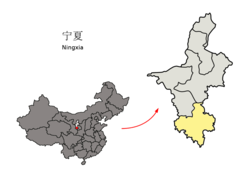
Back جويوان Arabic Gó-nguòng CDO Guyuan (lungsod sa Pangmasang Republika sa Tśina, Ningxia Huizu Zizhiqu, lat 36,01, long 106,28) CEB Ku-jüan Czech Guyuan (Ningxia Hui) Danish Guyuan German Guyuan Spanish Guyuan Basque گویوان Persian Guyuan Finnish
This article needs additional citations for verification. (January 2021) |
Guyuan
固原市 · قُيُوًا شِ Kuyuan; Kuyüan | |
|---|---|
 | |
 Guyuan City (yellow) within Ningxia | |
| Coordinates (Zhongxin Park (中心公园)): 36°00′36″N 106°15′25″E / 36.010°N 106.257°E | |
| Country | People's Republic of China |
| Region | Ningxia |
| Municipal seat | Yuanzhou District |
| Area | |
| • Total | 14,412.83 km2 (5,564.82 sq mi) |
| Elevation | 1,777 m (5,830 ft) |
| Population (2007) | |
| • Total | 1,455,200 |
| • Density | 100/km2 (260/sq mi) |
| GDP[1] | |
| • Total | CN¥ 21.7 billion US$ 3.5 billion |
| • Per capita | CN¥ 17,819 US$ 2,861 |
| Time zone | UTC+8 (China Standard) |
| Postal code | 756000 |
| Area code | (0)954 |
| ISO 3166 code | CN-NX-04 |
| Licence plate prefixes | 宁D |
| Website | www |

Guyuan (Chinese: 固原; pinyin: Gùyuán ), formerly known as Xihaigu (Chinese: 西海固; pinyin: xīhǎigù, Xiao'erjing: قُيُوًا شِ) or Dayuan (大原),[2] is a prefecture-level city in the Ningxia Hui Autonomous Region of the People's Republic of China. It occupies the southernmost section of the region, bordering Gansu province to the east, south, and due west. This is also the site of Mount Sumeru Grottoes (须弥山), which is among the ten most famous grottoes in China.[3] As of the end of 2018, the total resident population in Guyuan was 1,124,200.[4]
- ^ 宁夏统计年鉴2016
- ^ 徐锟. "宁夏固原市委书记滑志敏 让我们相约固原". cn.chinadaily.com.cn. Retrieved 2024-09-01.
- ^ "Guyuan Travel Guide: Location, Things to Do, Weather, Map". www.travelchinaguide.com.
- ^ 固原市2018年国民经济和社会发展统计公报 - 中国统计信息网. www.tjcn.org.
